
July 3, 2025
15 Genius Outdoor Kitchen Design Ideas That Will Blow Your Mind
Designing an outdoor kitchen that truly wows requires more than just a grill and a dream. Whether you're aiming for sleek modern outdoor kitchen design, cozy covered outdoor kitchen designs, or looking for expert advice from outdoor kitchen contractors , this guide will walk you through every step.
Let’s dive into how to design an outdoor kitchen that’s not only beautiful but functional and built to last.
1. Clarify Your Outdoor Kitchen Goals
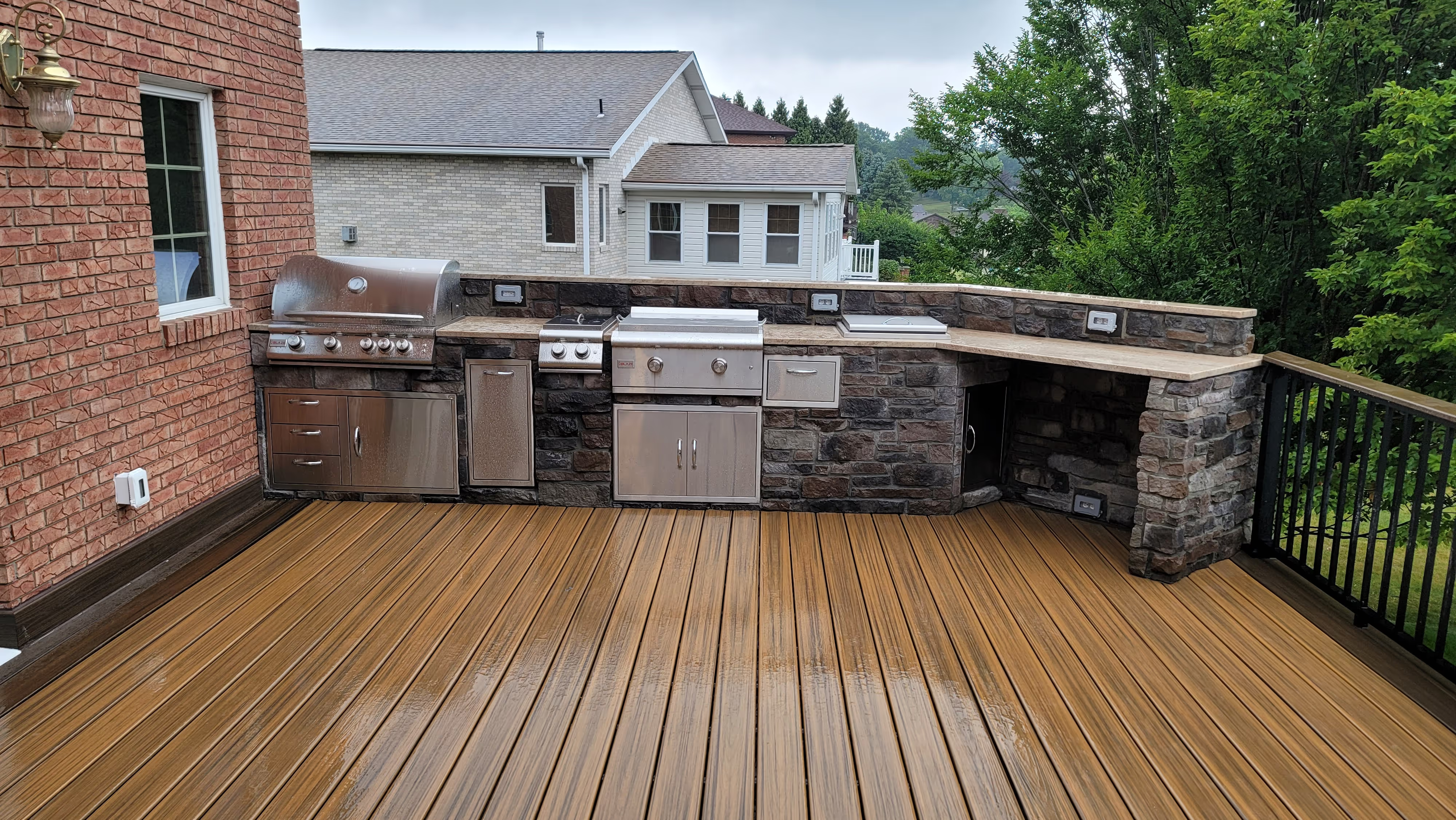
Start by identifying the purpose of your kitchen. Are you entertaining large crowds, hosting family cookouts, or looking for a relaxing culinary retreat?
Define must-haves like:
- A built-in grill
- Pizza oven
- Sink and refrigerator
- Bar or drink station
These preferences will guide your layout and appliance choices.
2. Pick the Perfect Location
Choose a spot that’s easily accessible from your indoor kitchen and dining area. Proximity reduces walking time during food prep and ensures seamless entertaining.
Pro tip: Keep wind direction in mind when planning where the grill will go.
3. Create a Smart and Functional Layout
Design your layout using the kitchen triangle rule: the grill, sink, and refrigerator should form a triangle for efficient movement.
Divide your outdoor kitchen into zones:
- Prep Zone: Includes cutting boards, counters, and sink
- Cooking Zone: Grill, burners, pizza oven
- Serving Zone: Dining area or bar counter
Read Also: How to utilize the space beneath your deck?
4. Select Durable, Weatherproof Materials
Your outdoor kitchen must stand up to the elements. Opt for:
- Stainless steel: Rust-resistant and easy to clean
- Concrete: Long-lasting and great for countertops
- Natural stone or tile: Stylish and durable for flooring and walls
Read Also: Top Brands and Materials for your Deck or Porch?
5. Invest in High-End Outdoor Appliances
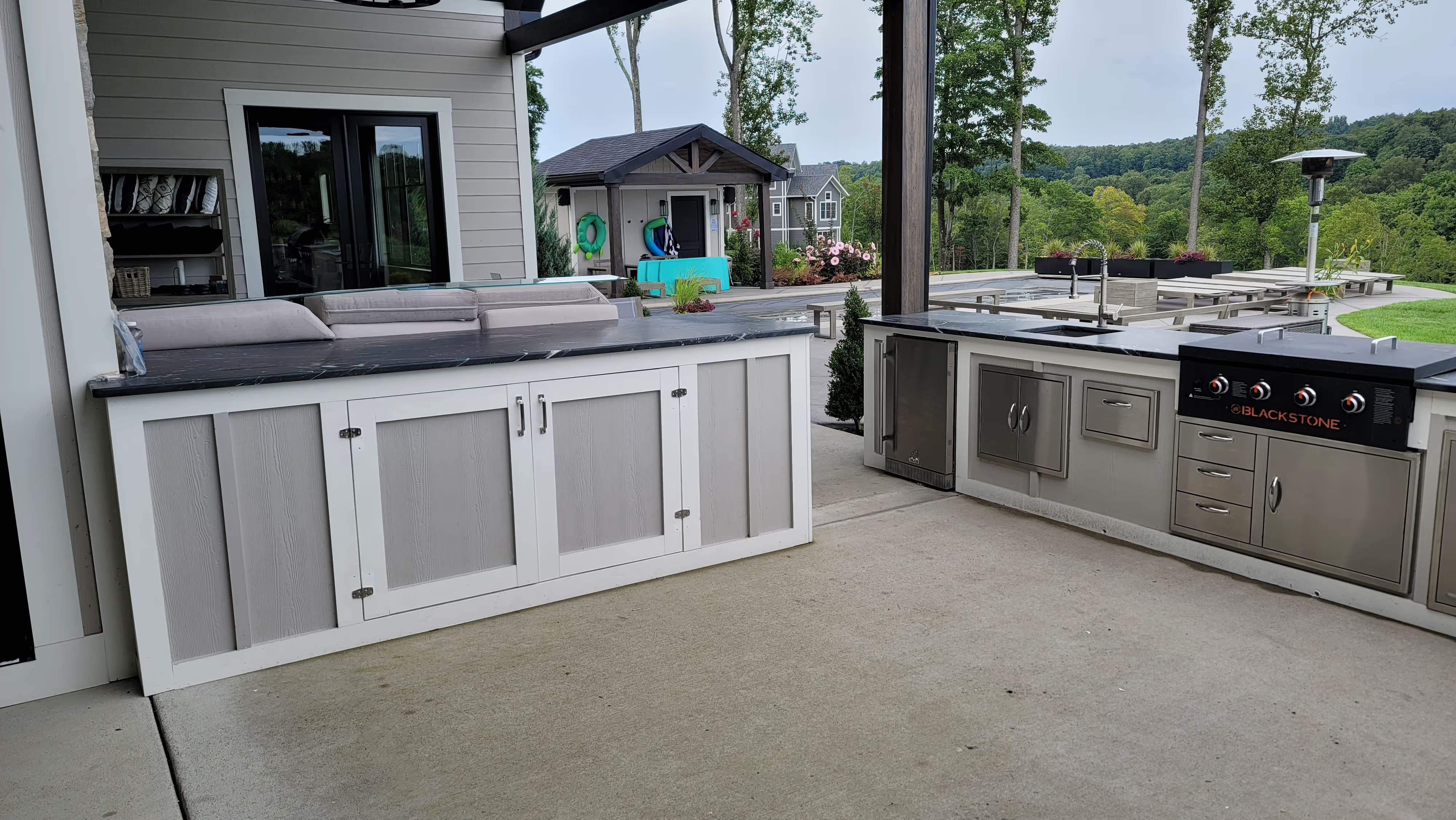
Look for appliances specifically made for the outdoors. Choose from:
- Built-in grills with side burners
- Outdoor-rated refrigerators
- Smokers or kamado grills
- Ice makers or wine fridges
Quality appliances elevate your cooking and hosting experience.
6. Add Smart Storage Solutions
Weather-resistant cabinets and drawers are essential. Use:
- Marine-grade polymer or stainless-steel cabinets
- Custom pull-out storage for utensils, cleaning supplies, or spices
- Hidden trash and recycling bins
7. Don’t Forget Comfortable Seating
Design your layout with guests in mind. Options include:
- Bar seating along the counter
- Outdoor dining sets
- Sectional or lounge furniture with cushions
The more comfortable your guests, the longer they’ll stay.
8. Light It Up for Evening Use
Your kitchen should shine day or night. Include:
- Task lighting over prep and cooking zones
- Ambient lighting under counters or seating areas
- Accent lighting in the backsplash or pergola
Solar and LED lights offer efficiency and style.
9. Style with Decorative Elements

Incorporate your personal taste with:
- Statement backsplashes
- Unique countertops
- Outdoor art or wall features
Make it a true extension of your home’s design.
10. Provide Shade and Shelter
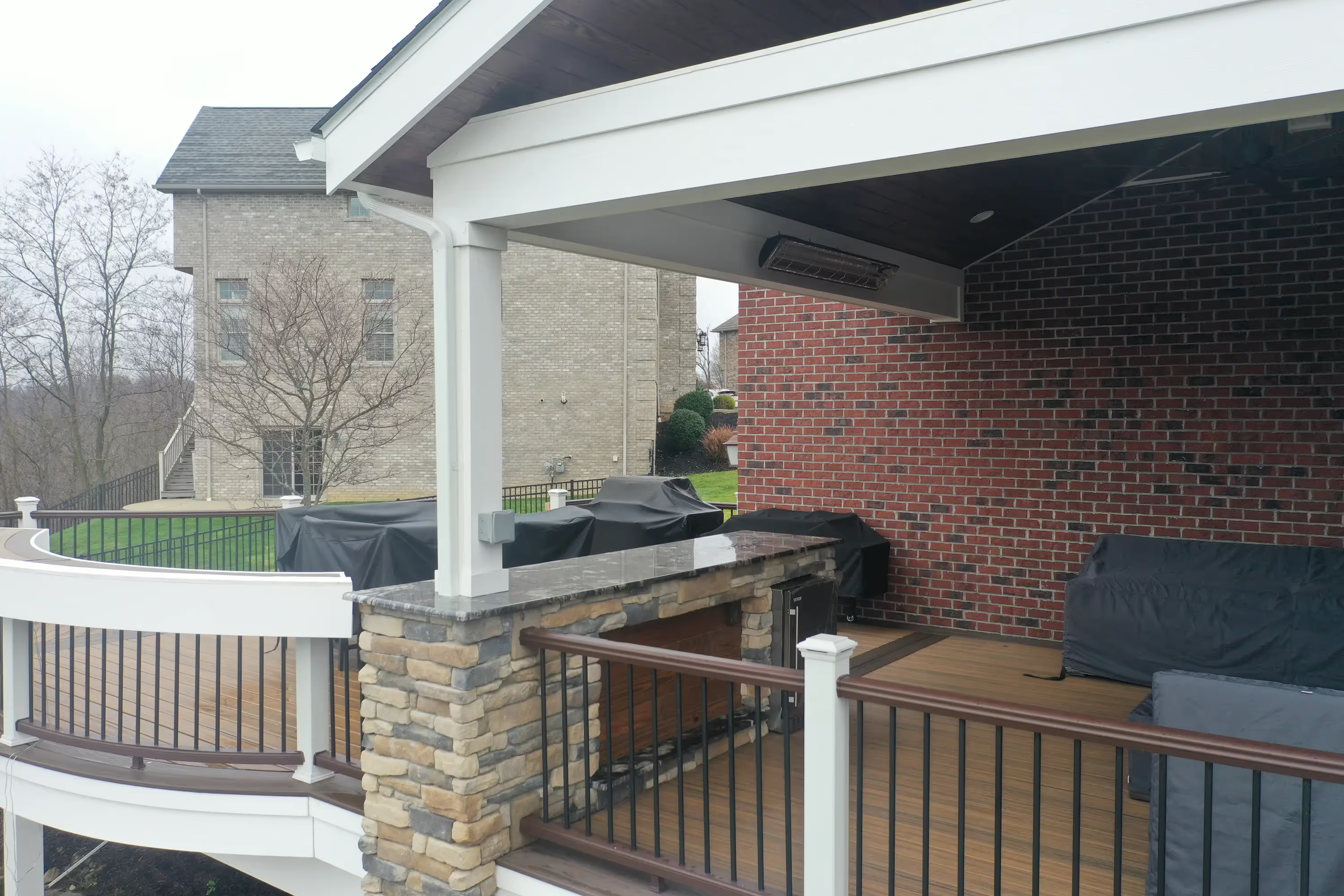
To maximize use year-round, include:
- Pergolas or pavilions
- Retractable awnings
- Built-in umbrellas
These structures offer protection from sun and light rain, ensuring comfort for you and your guests.
11. Incorporate Outdoor Entertainment Features
Add flair with:
- Weatherproof sound systems
- Outdoor TVs
- Fire pits or fireplaces
Entertainment creates an inviting vibe for movie nights and backyard parties.
12. Add Greenery and Natural Elements
Blend hardscapes with nature using:
- Potted herbs for cooking
- Vertical gardens or trellises
- Native landscaping for low maintenance
Plants soften the look and bring life to your space.
13. Ensure Proper Ventilation
Especially important in covered outdoor kitchens. Use:
- Vent hoods over grills
- Strategic fan placement
- Open walls or cross-ventilation designs
This helps keep smoke and heat in check.
14. Plan Utilities in Advance
Ensure access to:
- Gas lines for grills
- Water connections for sinks
- Electrical outlets for lighting, appliances, and entertainment
Hire professional outdoor kitchen contractors to handle installation safely.
15. Customize with Unique Features
Personalize your space with:
- Built-in wine coolers
- Flat-top griddles or tandoori ovens
- Bluetooth lighting or smart control panels
Let your kitchen reflect your personality and lifestyle.
Read Also: How SelectDecks completely transformed Pittsburgh Backyard with Outdoor Kitchen & Deck?
Build Your Dream Outdoor Kitchen Today
Creating a truly unforgettable outdoor kitchen comes down to thoughtful design and the right team of outdoor living professionals. Whether you're exploring outdoor kitchen design ideas or searching for a trusted outdoor kitchen contractor , it pays to partner with experts.
Work with SelectDecks – The Outdoor Kitchen Specialists
At SelectDecks, we build more than just decks—we create entire outdoor living spaces customized for your needs. Our team of expert outdoor kitchen contractors in Pittsburgh, Morgantown and Northern Virginia handles everything from design to installation, ensuring your kitchen is stylish, functional, and built to withstand the elements.
Why Choose SelectDecks?
- 5-Star Rated Contractors
- Custom Deck & Kitchen Integration
- High-Quality, Weather-Resistant Materials
- Design Consultations Tailored to Your Space
Contact us today to get your outdoor project started!
Check Out Our Other Blogs
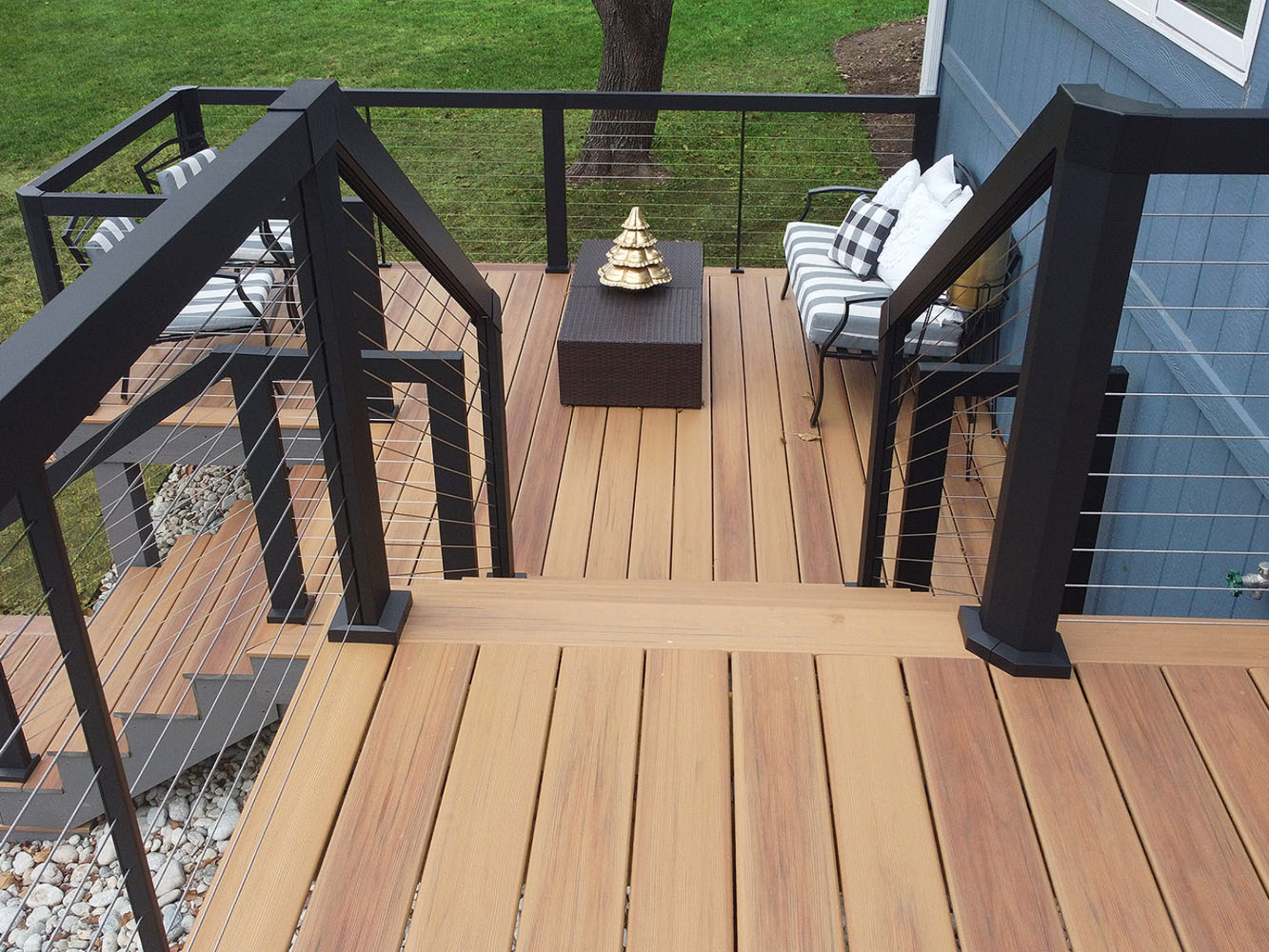
September 25, 2025
Transform Your Home with Safe and Stylish Handrails
Handrails are one of the most essential yet overlooked features in a home. From deck handrails and porch handrails to interior staircases and balconies, they provide critical safety, improve accessibility, and add style to your living spaces.
At SelectDecks, we believe handrails aren’t just functional—they’re an important design element that enhances your home’s look while keeping your family safe.
Safety First: The Role of Handrails
Handrails are more than decorative—they’re a must-have for safety. Whether it’s an outdoor handrail for steps or a staircase railing inside, they:
- Provide stability and support on stairs, decks, and ramps
- Reduce the risk of falls for children, seniors, and guests
- Help meet local building codes and safety regulations
A secure deck handrail or porch handrail offers peace of mind and makes your home more accessible to everyone.
From Function to Form: Handrails as Design Features
Handrails no longer have to be purely practical. With today’s options, you can seamlessly integrate safety with aesthetics.
Popular styles include:
- Stainless steel – modern and sleek
- Wrought iron – timeless and traditional
- Aluminum – strong, weather-resistant, and low-maintenance
- Glass panels – open, contemporary, and ideal for maximizing views
The right choice makes your decking and handrails stand out as a true design feature.
Read Also: Tips for designing a Deck or Patio for all Seasons
Outdoor Handrails: Decks, Porches, and Balconies
Outdoor handrails are essential for creating safe, beautiful living spaces. Whether for decks, porches, or balconies, they enhance design while providing security.
Best outdoor handrail materials:
- Aluminum – durable, corrosion-resistant, and built to last
- Composite or vinyl – low-maintenance with multiple color options
- Glass with metal framing – provides safety without blocking views
When designed well, outdoor handrails are more than a safety feature—they become a finishing touch that ties your entire space together.
Read Also: What is Composite Decking?
Interior Handrails: Elevating Staircases
Inside the home, stair railings can dramatically impact the look and feel of your space. Whether you want a traditional wood handrail or a modern glass system, the options are endless.
Considerations for interior handrails:
- Match your home’s architectural style
- Add lighting for elegance and visibility
- Combine wood, metal, or glass for a unique design
Custom Handrails: Built Just for You
Handrails can be tailored to match your personal taste and home’s style. Options include:
- Decorative patterns or engravings
- Custom finishes (matte, gloss, textured, or stained wood)
- Integrated lighting for beauty and function
Custom railings ensure your home reflects your vision—safely and stylishly.
Maintenance: Choosing the Right Handrail Material
Maintenance is an important factor when selecting handrails:
- Aluminum & stainless steel – minimal upkeep, long-lasting
- Glass – needs regular cleaning to maintain clarity
- Wood – requires sealing or staining to withstand weather
Choosing the right material ensures your handrails remain safe and beautiful with the level of upkeep you’re comfortable with.
Safety Meets Style
Handrails aren’t just code requirements—they’re opportunities to combine safety with design. From outdoor handrails on porches and decks to indoor staircases, the right handrail enhances your home’s look while keeping it safe.
At SelectDecks, we specialize in building decks, patios, porches including custom handrails across Morgantown, WV, Pittsburgh, PA, and surrounding areas. Whether you’re upgrading a deck handrail or designing custom porch handrails, our team ensures durability, style, and safety.
Ready to upgrade your space? Contact SelectDecks today and let’s design your dream deck with custom handrails!
FAQs About Handrails
1. How do handrails on stairs help keep you safe?
Handrails give you stability and support while climbing stairs, reducing the risk of slips and falls. They’re especially important for children, seniors, and guests with mobility issues.
2. How high should a handrail be?
Most building codes require handrails to be 34–38 inches high from the stair tread or deck surface. Always check local regulations to ensure compliance.
3. How to build deck handrails?
Building a deck handrail involves:
- Measuring your deck perimeter
- Installing sturdy posts
- Adding top and bottom rails
- Attaching balusters or panels
- Securing the handrail for strength
For a flawless finish, hiring outdoor professionals like SelectDecks ensures safety and style.
4. How to build porch handrails?
Similar to deck railings, porch handrails require posts, rails, and balusters. You’ll also want to choose weather-resistant materials like aluminum or vinyl for durability.
5. What are the best handrails for outdoor steps?
Aluminum and composite porch handrails are excellent for outdoor steps because they resist weather damage and need little maintenance.
6. Can handrails improve my home’s design?
Absolutely! From sleek glass systems to decorative wrought iron, handrails can transform both interior and exterior spaces into stunning focal points.
.avif)
September 15, 2025
Average Lifespan of Your Decks & Patios
A deck or patio isn’t just an outdoor upgrade — it’s an investment in your home’s comfort and value. In fact, studies show that a well-built deck can add up to 70% return on investment when selling a home, and outdoor living spaces remain one of the top five features buyers look for in real estate. But like every part of your home, decks and patios don’t last forever.
So, what’s the average lifespan of a deck or patio? The answer depends on more than just the materials used — climate, maintenance, construction quality, and usage all play a role. In this guide, we’ll break down how long different types of decks and patios last, the factors that shorten (or extend) their lifespan, and what you can do as a homeowner to make your outdoor oasis last for decades.
What Is the Average Lifespan of a Deck?
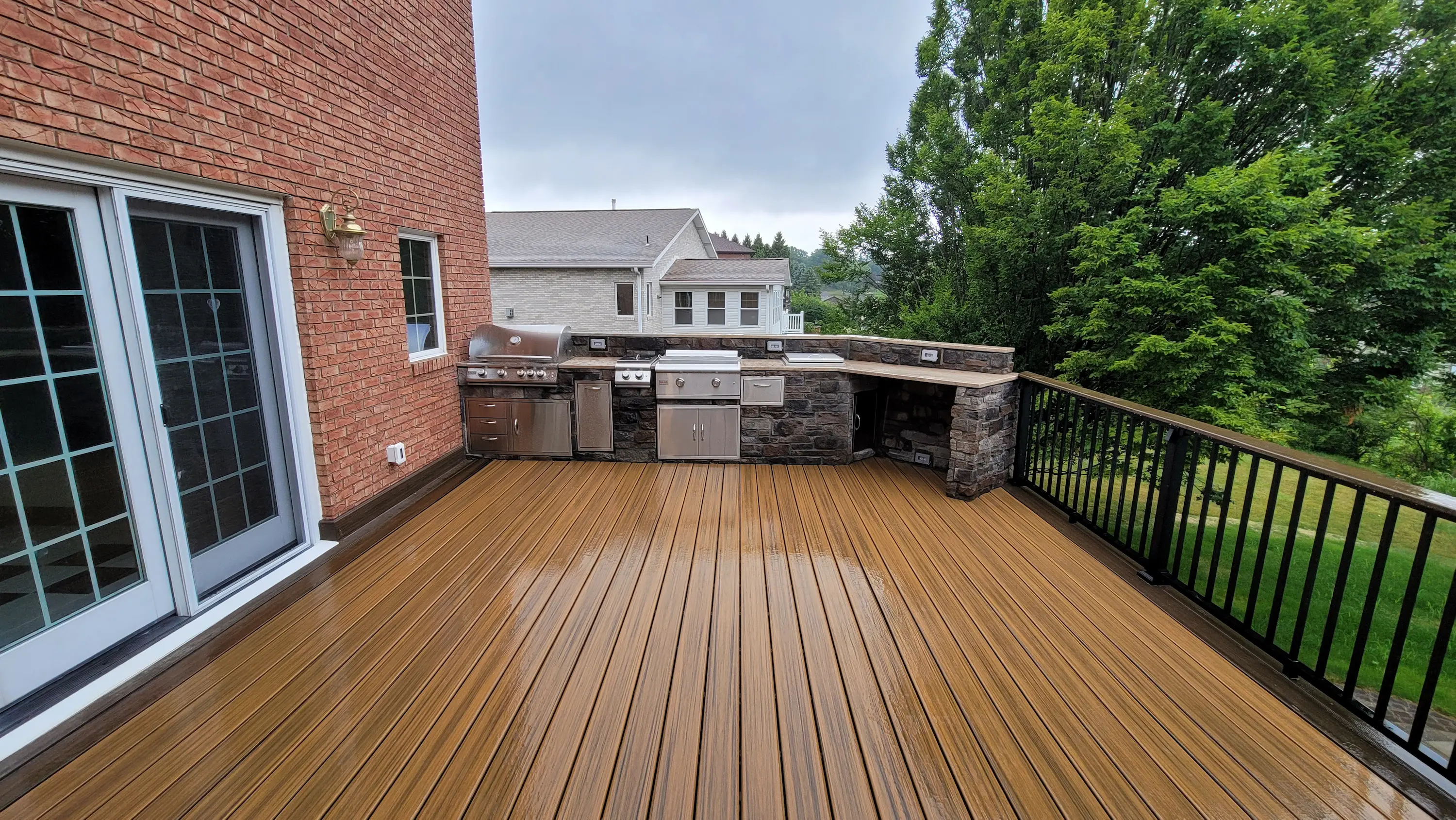
The average lifespan of a deck depends on material, climate, construction quality, and maintenance. On average:
- Pressure-treated wood decks: 10–15 years with consistent care.
- Cedar or redwood decks: 15–20 years with sealing and maintenance.
- Composite decking: 25–50 years with minimal upkeep.
- PVC decking: 30–50 years, resistant to rot and insects.
Your deck may last longer or shorter depending on how well it’s maintained and the conditions it’s exposed to.
How Long Do Patios Last Compared to Decks?

Unlike decks, patios are usually built at ground level from stone, concrete, or pavers. Their durability makes them a long-lasting choice:
- Concrete patios: 25–50 years but prone to cracking in freeze-thaw climates.
- Stone patios: 50+ years with proper installation.
- Brick or paver patios: 25–40 years with occasional joint repairs.
Patios generally outlast wood decks, but they’re not maintenance-free. Drainage issues, ground shifting, or water penetration can shorten their lifespan.
How Does Material Selection Impact Lifespan?
One of the most important factors that determines the longevity of outdoor structures is the material used.
- Wood: Affordable and attractive, but requires ongoing staining, sealing, and inspections to resist rot and pests.
- Composite decking: Made of wood fibers and plastic, this option resists warping, splintering, and decay, making it popular for homeowners who want longevity with low upkeep.
- Concrete patios: Strong and durable, though sealing is recommended to prevent surface cracking.
- Natural stone: Elegant and extremely durable, though upfront costs are higher.
Tip: Match your material to your climate. Wood may struggle in coastal humidity, while concrete may crack in freeze-prone areas.
How Do Climate and Environmental Factors Affect Lifespan?
Climate plays a major role in how long decks and patios last:
- Sun exposure: UV rays fade and weaken wood fibers over time.
- Snow and ice: Freeze-thaw cycles can cause wood warping or concrete cracks.
- Rain and humidity: Promote mold, rot, and insect infestation.
- Coastal environments: Saltwater accelerates wood decay and metal corrosion.
Choosing the right material for your climate, plus adding protective coatings, will significantly extend lifespan.
Why Is Maintenance So Important for Decks and Patios?
Proper maintenance and regular inspections are critical for keeping outdoor spaces safe and functional.
- Wood decks: Require sealing or staining every 1–3 years to prevent rot and insect damage.
- Composite decking: Lower maintenance, but still benefits from annual cleaning.
- Patios: Need joint sealing and periodic cleaning to prevent weeds, cracks, and shifting.
Routine inspections help spot early issues such as loose fasteners, rotting boards, or patio settling. Addressing these early can prevent expensive repairs later.
Does Construction Quality Impact Lifespan?
Yes — even the best materials won’t last long if installed incorrectly. Hiring an experienced builder ensures:
- Proper drainage and ventilation under decks.
- Corrosion-resistant fasteners and proper flashing.
- Compliance with building codes.
- Structural stability and safety for decades.
A poorly built deck might last only a few years, while a properly built and maintained one can last decades longer.
How Does Usage and Foot Traffic Affect Lifespan?
Another overlooked factor is how the space is used:
- Heavy furniture and gatherings: Can strain decking boards and fasteners.
- Pools and hot tubs: Increase water exposure, requiring stronger framing and more frequent inspections.
- Pets and kids: Add more wear and tear over time.
The more traffic your deck or patio experiences, the more essential regular upkeep becomes.
Conclusion: Build Smart, Maintain Well, and Enjoy for Decades
The average lifespan of decks and patios depends on material selection, climate, construction quality, and maintenance. By investing in durable materials, proper construction, and consistent upkeep, homeowners can enjoy safe, beautiful outdoor spaces for decades.
Ready to upgrade or build a new deck or patio? Contact SelectDecks today for expert design and craftsmanship that stands the test of time.
FAQs About Deck & Patio Lifespans
1. How long does a wood deck last without maintenance?
Typically only 5–7 years. Without sealing and repairs, wood deteriorates quickly.
2. Is composite decking worth the cost?
Yes. While it costs more upfront, composite lasts 2–3x longer than wood with minimal maintenance.
3. What’s the affordable long-lasting patio material?
Concrete is generally the most cost-effective, though pavers provide easier repair options.
4. Can you rebuild a deck using the same frame?
If the frame is structurally sound and built to code, resurfacing with new decking is often possible. Always inspect for rot or corrosion first.
5. How often should I inspect my deck or patio?
At least once a year — ideally in spring before heavy outdoor use.
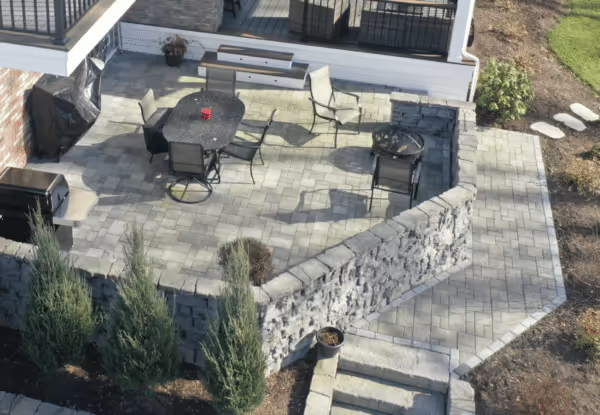
August 21, 2025
The Ultimate Guide for Choosing the Best Patio Finish
Your patio is more than just a place to put outdoor furniture—it’s where memories are made. Imagine friends and family gathered on your gorgeous new patio, sharing laughs, great food, and warm summer evenings. But before you can enjoy it, there’s an important decision to make: what material will your patio be built from?
Two of the most popular options we design and build at SelectDecks are paver patios and stamped concrete patios. Each has its own benefits, drawbacks, and style possibilities. In this guide, we’ll help you understand the differences so you can choose the right one for your home and lifestyle.
Paver Patios
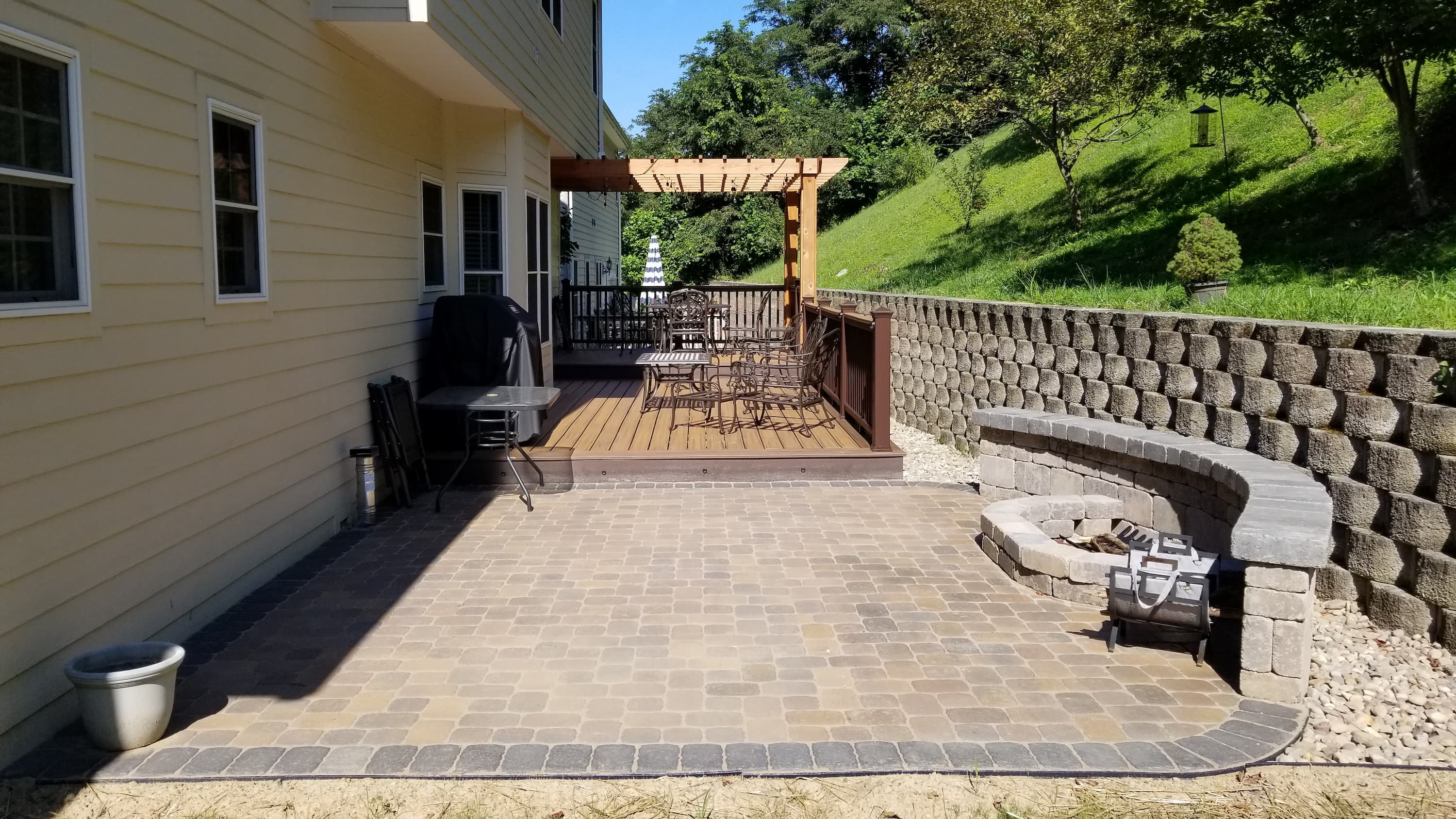
Pavers are known for their timeless style and design flexibility. They come in different materials, each with its own look and performance. Pavers come in many styles and designs, making them a perfect choice for a fully custom design.
1. Natural Stone Pavers – Rustic Beauty and Durability
Natural stone options like slate or granite bring a rich, organic look to your patio. They’re extremely durable and can handle harsh weather. The trade-off? They tend to be more expensive and require professional installation due to their weight and irregular shapes.
2. Concrete Pavers – Affordable and Versatile
Concrete pavers are a budget-friendly option with a wide variety of colors, shapes, and designs. They’re relatively easy to install and maintain, though they’re not quite as durable as natural stone and can develop cracks over time.
3. Clay Pavers – Classic Charm That Lasts
Clay pavers are a traditional option that can add a classic touch to your patio. They are durable and resistant to fading, making them a popular choice for outdoor spaces. However, they can be expensive and may require professional installation.
Read Also: Tips for Designing a Patio for All Seasons
Concrete Patios
.jpg)
Concrete is another popular material for patios. It is affordable, durable, and can be customized to fit any design style. Concrete is a popular option for those looking to fully customize the way their patio looks. There are various types of concrete available, including stamped concrete, exposed aggregate, and colored concrete.
1. Stamped Concrete
Stamped concrete is a popular option that can mimic the look of natural stone, brick, or wood. Concrete is poured, stamped, and then covered in a colored powder (called a relief) that gives the concrete contrast and texture. At SelectDecks, we like using stamped concrete for patios due its versatility and the numerous ways it can be customized. It is durable and requires little maintenance, making it a great option for busy homeowners. However, it can be prone to cracking and may require resealing every few years.
2. Exposed Aggregate Concrete
Exposed aggregate concrete is a stylish and unique option that features a textured surface with exposed stones and pebbles. It is slip-resistant and durable, making it a great option for high-traffic areas. However, it can be challenging to clean and may be prone to cracking over time.
3. Colored Concrete
Colored concrete is a versatile option that can be customized to fit any design style. It can be tinted to match the color of your home or surroundings, making it a great option for creating a cohesive look. Colored stamped concrete can bring an entire area together. However, it can be prone to fading and may require resealing to maintain its color.
Read Also: Differences between Deck vs Patio vs Porch
How to Choose the Right Patio Material for Your Lifestyle?
When deciding between paver patios and stamped concrete, consider:
- Budget: Pavers cost more upfront; stamped concrete is usually more affordable.
- Design Flexibility: Both offer customization, but pavers allow more modular creativity.
- Maintenance & Repairs: Pavers are easier to repair; stamped concrete may require resealing.
- Climate: Pavers handle freeze–thaw cycles better, making them ideal for colder climates.
By weighing the pros and cons of each material, you can choose the perfect option to create a beautiful and functional patio that you can enjoy for years to come.
When working with a professional patio builder, they’ll consider your wants and needs and work with you to get to a solution you’ll love for years to come.
Paver Patios vs. Stamped Concrete — Key Differences
Let’s Build the Perfect Patio for Your Home
At SelectDecks, we help homeowners make the most of their outdoor spaces with custom-built paver patios and stamped concrete patios in Pittsburgh, Morgantown, and Northern Virginia. Whether you want a simple design or a complete outdoor living transformation, we’ll recommend what works best for your home, lifestyle, and budget.
Contact us to get started or you can download our free pricing and project guide.
Ready to Create Your Dream Outdoor Space? Contact Us Today!
